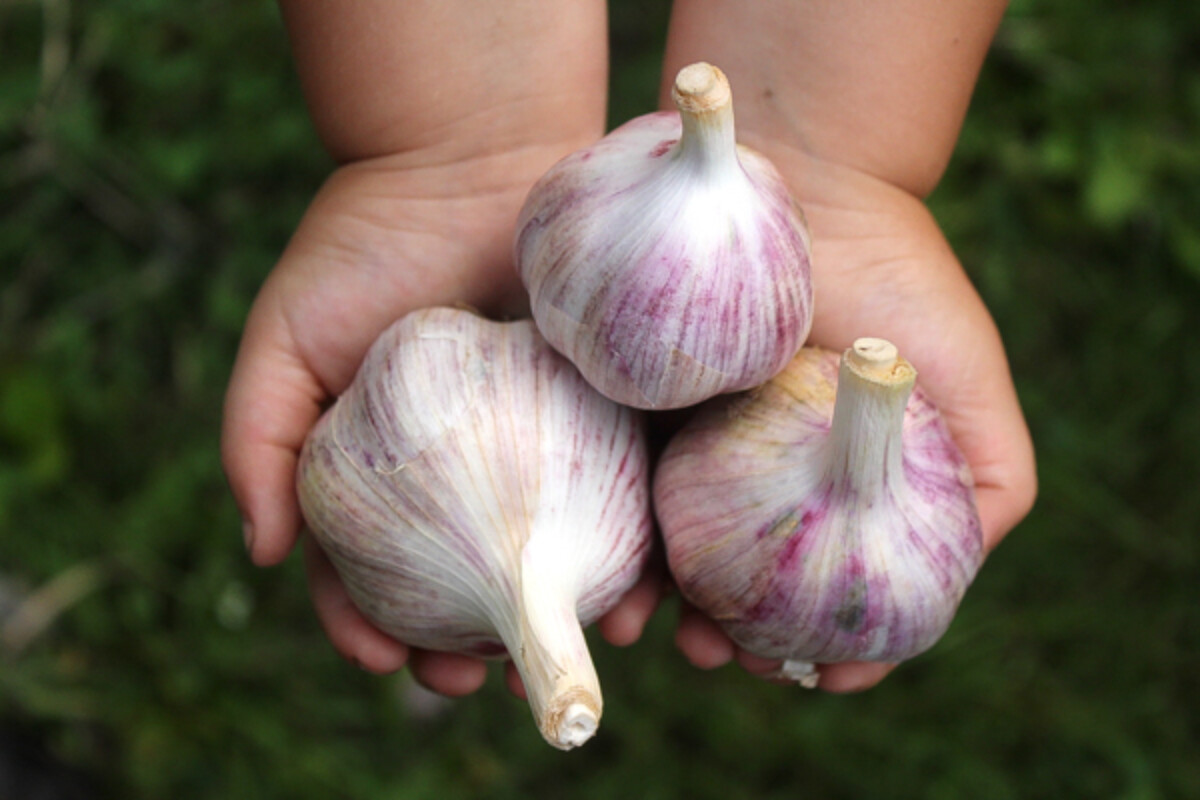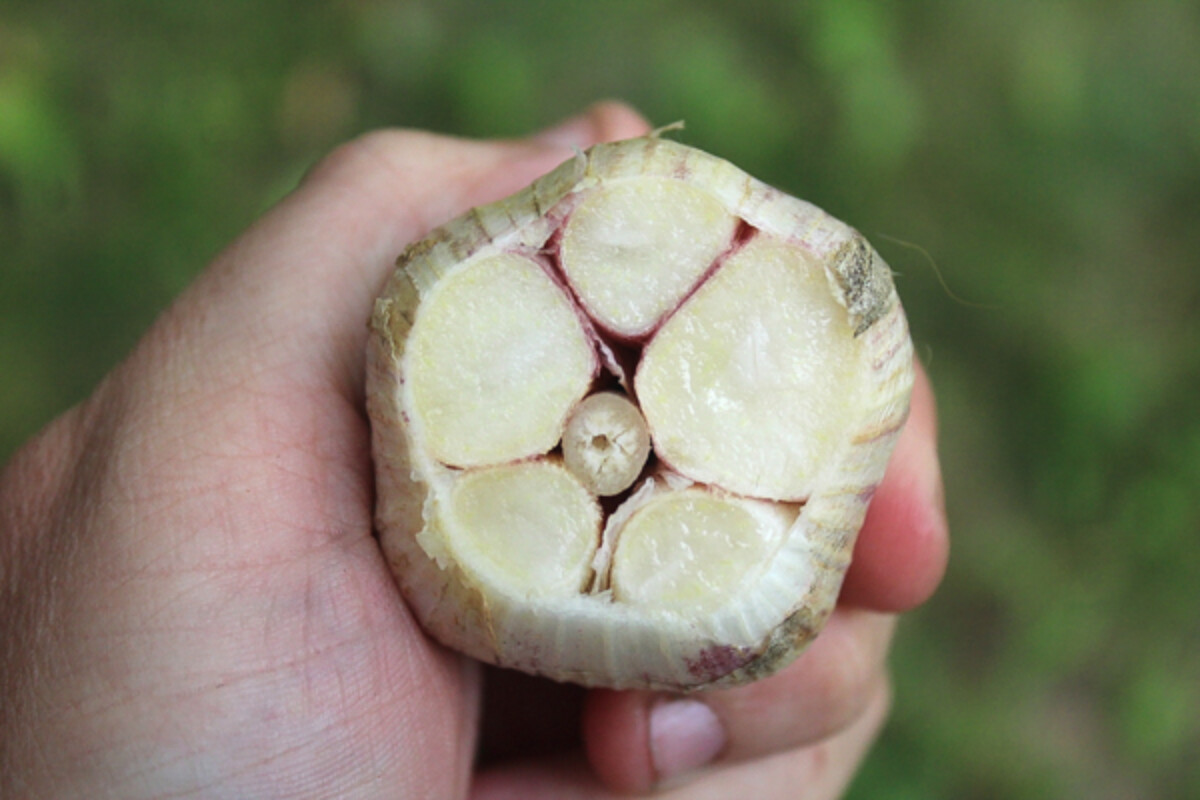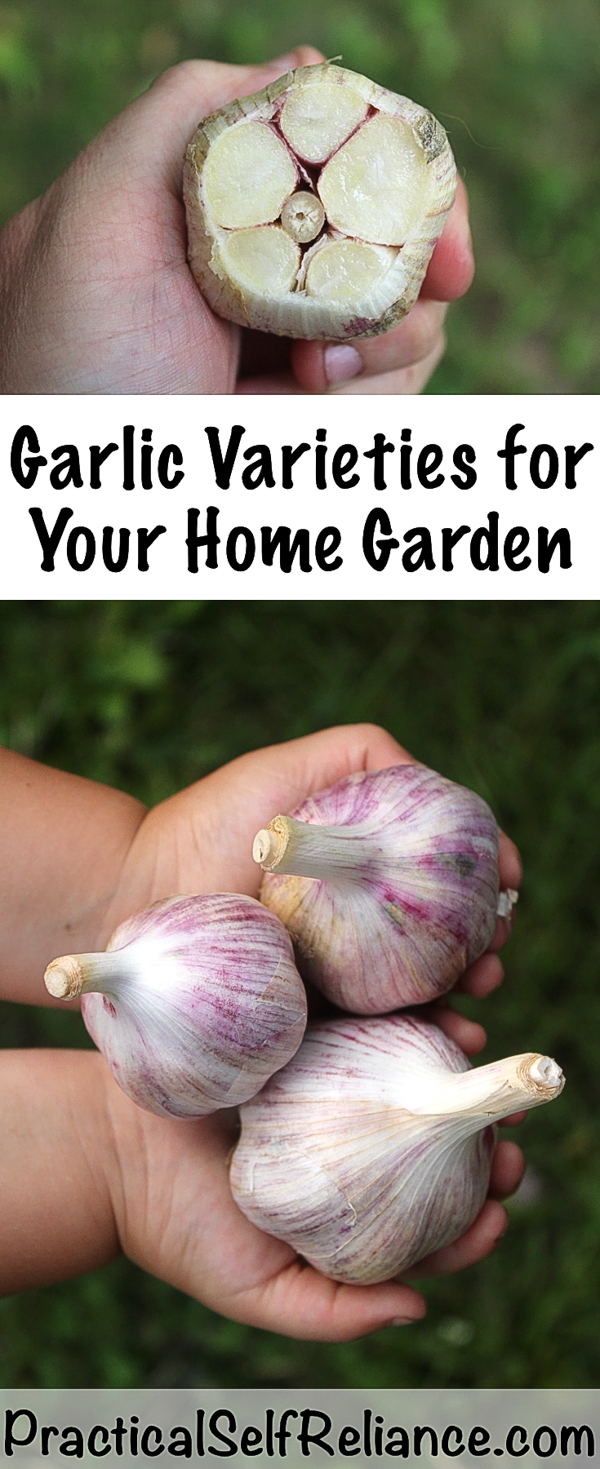Affiliate disclosure: This post may contain affiliate links. Please see our Privacy Policy.
If you buy your garlic from the supermarket, chances are you’ve only ever tried one type. Home gardeners have dozens of options, each with its own unique characteristics and flavor. There are so many types of garlic, that it can be a bit difficult to understand how to choose garlic for your backyard garden.
True garlic (Allium sativum) has two main subspecies, softneck and hardneck garlic. Within those subspecies, there are 2 subtypes of softneck and 8 subtypes of hardneck garlic.
After that, there are individual garlic varieties within each subtype. That all adds up to more than 100 varieties of garlic, and a lot of decisions for the home gardener.

Hardneck Garlic Varieties
Hardneck Garlic (Allium sativum ophioscorodon) produces a rigid central stalk and a secondary harvest of garlic scapes in the spring. Garlic scapes are the flower stalks of hardneck garlic, and they’re usually cut off to allow the plant to devote energy to the developing bulb.
Hardneck garlic tends to have better flavor than softneck and generally outperforms softneck garlic in colder climates.
There are 5 recognized types of hardneck garlic, as well as 3 “bonus” types of garlic that are currently recognized as hardneck but don’t always produce hardneck crops. I’ll discuss those three under intermediate varieties (Creole, Asiatic and Turban).
- Porcelain Hardneck Garlic – Big cloves with smooth white wrappers are attractive at markets. Porcelain garlic varieties are easy to grow and adapt to a variety of growing conditions. They’re good keepers, lasting 8+ months and have a strong garlic flavor. Their cloves are extra large, and each bulb will produce 4 to 6 huge cloves, each wrapped in a red/brown skin.
- Rocambole Hardneck Garlic – Noted for having the best flavor of any type of garlic, rocambole varieties are the standard for home gardeners that seek the absolute best garlic flavor. That spectacular flavor comes at a price, ad rocambole garlic varieties can be a bit finicky about overwatering and won’t perform well in wet years. They also require hotter summers than other varieties.
They produce bulbs with 8 to 12 cloves, and the papers come away clean making them especially easy to peel. Red/brown skins cover individual cloves, but the exterior wrapper will vary in color from red to pink and striped. Rocambole garlic doesn’t keep quite as long as porcelain but often keeps 6 months or more.
- Purple Stripe Hardneck Garlic – Originally the only type of “purple stripe” garlic, the next two varieties were previously classed as part of the purple stripe group. All three varieties are easy to grow and produce bulbs with 8 to 12 tall, slender cloves. All purple striped garlic varieties are noted to be superior for roasted garlic. Notable varieties include purple star.
- Marbled Purple Stripe Hardneck Garlic – Similar to Purple stripe garlic, but bulbs often have fewer larger cloves. Marbled purple stripe garlic varieties need extra attention during curing, especially in wet years because they have a tendency to hold moisture. Notable varieties include Duganskij, Kahbar and Gourmet Red.
- Glazed Purple Stripe Hardneck Garlic – Similar to Purple stripe garlic, but bulbs often have fewer larger cloves. The paper wrapper on this variety can be a bit thin, making them more delicate than other varieties. They may not keep as well, and care has to be taken during harvest.
Since this variety is tender, it can be hard to find and isn’t generally grown commercially. It’s kept alive by heritage conservancies and dedicated family growers. Notable varieties include Purple Glazer and Red Rezan.

Softneck Garlic Varieties
Softneck garlic (Allium sativum sativum) is the type of garlic that is typically sold in grocery stores. It has a soft and braid-able stem. It’s grown commercially because it can be planted mechanically, and doesn’t require effort midseason to trim off the garlic scapes.
Softneck garlic is often described as milder flavored, or as having a more gentle vegetable flavor, rather than the full flavor (and heat) of hardneck garlic varieties. They’re best suited to warmer climates, zone 5 and above.
Softneck varieties tend to have many small cloves, which means that there are more plantable cloves per bulb. That’s better for commercial production but rather inconvenient for the home cook that has to peel all those small cloves. There are two subtypes of softneck garlic.
- Artichoke Type Softneck Garlic – Large cloves mean that this variety of garlic can have trouble with longer storage. Moisture can get trapped on the inside and cause spoilage. Watch for interior mold, but if dried properly and kept in the right conditions, Artichoke garlic can last up to 8 months.
- Silverskin Type Softneck Garlic – This variety tends to be a bit smaller than artichoke, and dried better for long-term storage. Silverskin softneck garlic can keep over a year in the right conditions.
Intermediate Garlic Varieties
Beyond the 5 recognized garlic varieties, there are also three more varieties just recently classed as hardneck. They’re not “true” hardneck garlic, and they don’t always produce hardneck crops.
They’re often called weekly bolting hardnecks because they occasionally fail to produce hard necks and produce soft neck garlic instead. They’re more or less a middle ground or intermediate varieties between hardneck and softneck.
Hardneck varieties tend to do better in cold climates, like zone 4 or colder. These intermediate varieties often have more hardiness than softneck varieties, and the fact that they often produce softneck bulbs means that growers in cold climates can have braid-able varieties of garlic.
In this intermediate group, there are three distinct sub-groups.
- Creole Garlic
- Asiatic Garlic
- Turban Garlic
All three varieties can be somewhat difficult to find, and I can’t find any definitive information about the distinctions between the three sub-groups. In general, the intermediate varieties have a strong flavor, like that of the hardnecks and they often have vibrant colored skins.
Elephant Garlic
Though it’s often called garlic, elephant garlic is actually a completely different species (allium ampeloprasum). The flavor is much like softneck garlic in that it’s mild. The main reason people choose to use elephant garlic is the size of the cloves.
There are a few large cloves, like with hardneck garlic, but without the intense hardneck flavor. Elephant garlic saves you a lot of time peeling garlic, but there’s not much flavor in the cloves. If I’m growing garlic, I want to taste it, so I opt for hardneck varieties.
Best Garlic Varieties to Plant
The best garlic varieties depend on your own personal taste, as well as your climate. If you’re in a warm climate that doesn’t have a hard freeze in the winter, stick with softneck varieties. For those in colder climates, choose a hardneck variety.
Porcelain are the longest storing hardneck varieties, and the most dependable. Rocambole are said to have the best flavor, but they need a warm, dry summer to produce well.
That said, within each garlic subgroup, there are dozens of varieties. All told, there are more than 300 named garlic varieties and probably many more passed down through family gardeners that have never been classified by commercial growers.
There are always unique varieties that will do better in your own particular location, and saving cloves from your best producers will eventually result in a garlic strain that’s perfectly suited to your own growing conditions.
In addition to our annual plantings, we grow garlic as a perennial in our permaculture plantings. It helps keep pests away from the fruit trees and propagates itself. As an added bonus, we know the surviving plants are perfectly adapted to our microclimate, and we just divide them out for use as seed garlic cloves.
This year, I’m excited to try out a new variety called “Georgian Fire.” It’s supposed to have more heat than other varieties and a much more intense flavor. Bring it on I say! We’ll see if it lives up to its reputation.















I’m interested in planting some garlic right now (June 6th), for pest deterrence. I’m in zone 7, can I just plant some garlic cloves? BTW – These articles have me interested in planting some in the fall for harvest next year though!
If you are able to find garlic right now to plant, I definitely don’t see any reason why you couldn’t plant it right now especially if you are planting it for pest deterrence.
Good Morning, A long time biodynamic grower of Garlic told me to never pick garlic before at least the first 5 leaves have dried off and not pull but lift the bulb.
I planted some garlic last fall, and tried pulling one up in March – and it had no bulbs at all. Not even a tiny one, just a mass of soft springy roots. What did I do wrong? I have left the others intact
They’re harvested in early July here, after the tops begin to yellow. Most locations, garlic gets established in the fall and then starts growing in early spring. It’s not fully ready until mid-summer.
Thanks for helping me understand